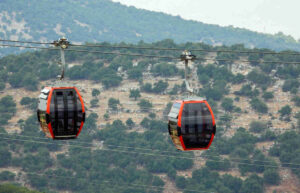All the capitals of the world have a street that stands out for its commercial and leisure atmosphere. So if you’re wondering what Amman’s shopping street is, the answer is Rainbow Street, in the Jabal Amman neighborhood, i.e. in the upper part of the city. Although we already told you that it does not have the hustle and bustle or density of establishments that in other large cities, it is an artery with its own character that, if you have enough time on your trip, you can travel at your own pace.
Why is it called Rainbow Street?
One of the curious things about Rainbow Street in Amman is that, officially, it is not called that: its original name is Abu Bakr al Siddiq Street, but it was popularly called Rainbow Street because of the cinema-theater that is located in its first section.
It was later when, inspired by the name and to give it context, some establishments on the street decorated their façades or even the street lamps and wiring with the colors of the rainbow which, by the way, are not directly related to the LGTBi symbology of Western countries.
What to do on this street?
Rainbow Street, Amman’s shopping street, is often listed in tourist guides as an essential artery for every traveler. However, its visit is rather recommended for those who have enough time to enjoy it slowly, without rushing, since the interesting thing about it is its atmosphere, especially in the afternoon.
The highlight of Rainbow Street are its cafes and restaurants, some of them international and others traditional. Here you can, for example, taste a typical local tea or smoke a shisha, two defining aspects of Arab culture in general and Jordanian life in particular. Some of these cafés have a certain literary air, which invites you to relax, either because of their garden or their terrace.
But rooftop bars or restaurants have also emerged in recent times, allowing you to have lunch or dinner with spectacular views of the surroundings, taking advantage of the elevated location of this neighborhood. In them or in other pub-type venues, you can even have a more sophisticated cocktail.
There are also some interesting shops along the street, such as home goods with a signature stamp. There is no shortage of leather shops, which is known as leather goods but is not really exclusive to that country but to many others of Arab culture. In addition, there are also bookstores, either generalist or with different themes.
But for lovers of art and collecting, the interesting thing is not limited to Rainbow Street: in the surrounding streets you will find art galleries with works made by local artists, in abstract, naïve style and other avant-garde proposals that are simply unclassifiable.
On the other hand, the street has no major cultural institutions, except for the headquarters of the British Council. The aforementioned Rainbow Theater is still in operation and is a good place to witness film cycles, sometimes linked to festivals or lecture series. It also has a small stage, which favors the organization of small performances.
Architecturally, you will find buildings from the 20th century, the most interesting being those from the beginning of that century, when small garden villas were designed that today are the headquarters of foundations or institutions, such as Mango House, in the rationalist style in vogue, with its characteristic curved balcony.
And in general, strolling along this street can be interesting if you have time, giving away some pleasant pictures, such as perspectives of the surrounding streets and panoramic views of the surrounding hills.



